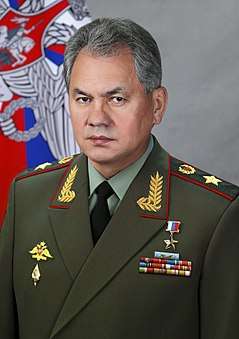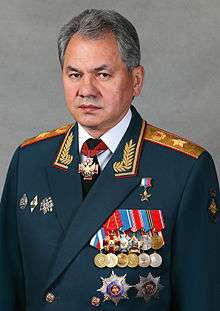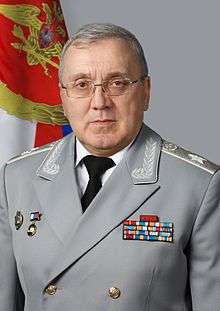Uniforms of the Russian Armed Forces
The Russian Armed Forces use an extensive system of Uniform which was inherited from the Soviet Armed Forces but modified throughout the years.

Overview
Specific items of uniforms and equipment of servicemen of the Armed Forces of the Russian Federation (the Armed Forces of the Russian Federation), as well as the rules for wearing them during the period from the beginning of the 1990s. Up to the present, established by the highest governmental bodies for the personnel of the Russian Armed Forces. Traditionally, it is divided into ceremonial, everyday and field, and each of them, in addition, to summer and winter. Military uniforms are worn strictly in accordance with the Rules for wearing military uniforms by servicemen of the Armed Forces of the Russian Federation, which are approved by the order of the Minister of Defense of the Russian Federation. These Rules apply to servicemen who serve in the Armed Forces of the Russian Federation, pupils of the Suvorov military, military musical and Nakhimov naval schools, cadet and cadet naval corps, as well as citizens discharged from active military service in reserve or resigned with the right to wear Military uniforms.
In modern Russian military uniforms, there is a certain continuity with the military form of the Russian Empire and the Soviet Union. In particular, with some reservations, the traditional division of the base color of the form by type of troops for the navy, ground forces and aviation, respectively, of black / green / blue, is preserved, similar to the form worn by the military of the Russian Empire and the Soviet Union in different periods , Although, strictly speaking, this division is fair, first of all, for the color of dress uniforms (and even then not always).
A) In the navy, there is a wide variety of clothing sets that have colors other than traditional for the Russian fleet, in particular, navy blue (for example, flannel, naval suit (work dress)) and white (for example, Summer dress and dress uniform for officers wearing to wear at high air temperatures, as well as foreman).
B) The so-called "green" color of the form of the ground forces, in fact, can mean:
The color of the naval wave of the officers' uniform of the Armed Forces of the Russian Federation, restored from 2010 (also in force until 1994), which has continuity with the color of the uniform uniform of the officers of the USSR Armed Forces, as well as the uniform of the officers of the infantry and artillery units of the Russian Empire of the 19th and early 20th centuries . The olive color of the ceremonial and casual clothes of soldiers and officers of the Armed Forces of the Russian Federation during the period from 1994 to 2010, which, although close in color, is still different from the khaki (which, strictly speaking, it is difficult to call green) everyday and field (As well as, parade for soldiers) uniforms of soldiers and officers of the USSR Armed Forces and field uniforms of soldiers and officers of the Russian Empire (after 1907). Since 2010, the olive color of uniforms and uniforms of soldiers and daily uniforms of officers of the Armed Forces of the Russian Federation has acquired an even brighter green shade, so that the color differences have become even stronger.[1].
C) Continuity of blue color is valid for the uniform uniform of the officers of the Air Force, Airborne Forces and the Russian Federation and the USSR. The blue color of the uniforms of officers of these types and types of service was not always the same - in the USSR, the uniforms of the officers for a long time were khaki colors, like the uniforms and uniforms of soldiers; The blue uniform was only the form of the Air Force commander in the period of the 1920s and 1930s. (With interruptions). Also in the Armed Forces of the Russian Federation there are a number of uniform supplies that were used in the USSR and the Russian Empire.
For example, a general view of the girdles and shoulder straps of ceremonial calculations and honor guard units in especially solemn occasions, such as parades on Red Square and other cities on the occasion of state and military holidays, a meeting of heads of state and government delegations, solemn ceremonies and military honors.
History
1992-1996
The Armed Forces of the Russian Federation were established by the Decree of the President of the Russian Federation, Boris N. Yeltsin, No. 466 in May 1992. Prior to this, on 21 December 1991, the CIS member countries agreed to maintain a unified command of the Armed Forces until they were reformed. The Supreme Commander-in-Chief of the United Armed Forces (since February 14, 1992 - the Supreme Soviet of the CIS) became the former USSR Defense Minister, Marshal of Aviation EI Shaposhnikov. In March 1992, the Joint Armed Forces of the Commonwealth of Independent States (CIS Armed Forces) and the Joint Command of the Allied Forces of the CIS were formed, which included the former USSR Armed Forces (primarily the Soviet Army and the Navy).[2]
On 11 February 1992, in the order of the Commander-in-Chief of the CIS Armed Forces No. 50 "On temporary changes in the military uniform for the period 1992-1995", a description was given of "temporary changes" in uniforms, and in fact - a new form of clothing for the transition period: For the marshals and generals, a ceremonial cap was introduced, modeled on the everyday, the parade uniform-dress uniform according to the pattern of the everyday jacket, but with ceremonial epaulettes, dressed-out trousers without boots, with edges along the line, and also authorized officer's model caps were allowed in the summer Everyday form for building;
For the marshals, generals and colonels were abolished hats (they were replaced by astrakhan hat-earflaps of gray color, for the colonels - from the fur of tsigeyki): The edges of the ceremonial uniforms of officers, ensigns, servicemen of the extended service and women servicemen, as well as armor-type armplates for the last three categories mentioned, were abolished; A cockade was introduced with the emblem of officers, warrant officers, and servicemen of super-long service wearing the same for everyday and dress uniforms;
Berets for military servicemen and caps for ceremonial dress uniforms of military servicemen were replaced by officer-type pilots; Woolen jacket of marshals, generals, officers, ensigns and servicemen of extra-long-term services changed the button fastener with a zipper, lined breast pockets for overhead (and also sewn side pockets on zippers);
For the marshals, generals and officers and generals, ensigns and servicemen of extra-long service excluded the ceremonial belts as well as the shoulder strap of leather equipment;
For conscripts and cadets a uniform woolen uniform was fitted with sewn epaulettes of the same material in place of the parade-out uniform and closed everyday jacket;
The letters "CA" were abolished on shoulder straps of shoulder straps of servicemen of urgent service, while wearing of metal letters "K" on sewn shoulder straps of field jackets and everyday cadets of cadets was established; The wearing of buttonholes on the collars of the woolen and cotton cottons of military service and cadets was canceled, while the golden emblems (on cotton tunics - protective) were fastened in the corners of the collars. The same document introduced the following changes in the form of generals, compared with the form of the Soviet Army in 1988: Sewing on ceremonial caps and uniforms of generals became similar to everyday and disappeared from the cuffs (along with the sutured edge on the collar and cuffs), Trousers were set to the gray front-and-back tunic, with cuffs, but without lamphas, in the tone of the tunic, and also a cap with a gray crown and colored band.
Thus, in the first year after the collapse of the USSR, the Armed Forces of the Russian Federation continued to wear the military uniform of the Soviet Army, in general outlines the shape of the 1988 model. Since 1994 the field uniform had the special, but non official the sleeve insignias: the branch of service or the military unit[3].
Different uniforms
 Sergey Shoigu in dress uniform
Sergey Shoigu in dress uniform ... open collar parade uniform
... open collar parade uniform.jpg) ... closed collar parade uniform
... closed collar parade uniform Ruslan Tsalikov in a gray dress uniform
Ruslan Tsalikov in a gray dress uniform ... everyday uniform
... everyday uniform
References
- ↑ Тельманов Д. Шойгу переоденет сотрудников в «офисную» форму со звёздами // Сайт газеты «Известия» (izvestia.ru) 16 августа 2013.
- ↑ Соглашение об Объединённых Вооружённых Силах на переходный период от 20 марта 1992 г. — цит. с сайта Единого реестра правовых актов и других документов Содружества Независимых Государств (cis.minsk.by) Retrieved 2016-08-23.
- ↑ http://paris1814.com/tankmuseum/russia-uniform